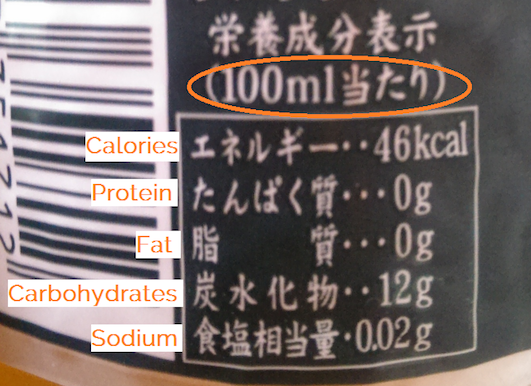41 how to read japanese nutrition labels
The Ultimate Guide to Reading Food Labels in Japan ... Most labels similar to this type will then list total protein (たん白質), fat ( 脂質), carbohydrates (炭水化物), and sodium (ナトリウム), and some will list sugar, but many count sugar under the "carbohydrate" category and don't always split them so you can see how much of the carbs are sugars. It varies though. How to Read Japanese Food Label | Coto Language Academy Guide to Your Japanese Food Labels Guide to your Japanese Bathtubs Vocabulary: エネルギー (enerugi-) Energy たんぱく質 (tanpakushitsu) Protein 脂質 (shishitsu) Fat 炭水化物 (tansuikabutsu) Carbohydrate 糖質 (toushitsu) Sugar 食物繊維 (shokubutsuseni) Fiber 食塩 (shokuen) Sodium 低カロリー (teikarori-) Low Calorie 高たんぱく質 (koutanpakushitsu) High Protein 無糖 (mutou) No Sugar
Reading Japanese Food Labels - Allergens and Tips Food labels are 食品表示 (しょくひんひょうじ shokuhin hyou ji) in Japanese. Let's take a look at a food label before going on into the various parts of Japanese food labels and how to read them. Below is the label to a popular brand of barley (mugi) tea. Lots of text here, but if you look closely the label actually consists of 2 parts.

How to read japanese nutrition labels
Be Sure to Read Labels for Portion, Calorie Control ... Start by looking at the number of servings in the package and the calories in each of those servings. Realize that if the calorie count is low because the serving size is very small, one portion may not satisfy you. Next, look at the nutrients. Fat grams deliver twice the calories of protein and carbs, so keep them in check. Chowhound Thank you for making Chowhound a vibrant and passionate community of food trailblazers for 25 years. We wish you all the best on your future culinary endeavors. How to Read Nutritional Labels in Chinese - Blogger The nutrition labels usually offer the following facts, and typically in this order: 熱量 (Re4 Liang4) Energy ( units = 大卡 / da1 ka3 / Kcal) 蛋白質 (Dan4 Bai2 Zhi4) Protein (unit = 公克 / gong1ke4 / gram) 脂肪 (Zhi1 Fang2) Total Fat (unit = 公克 / gong1ke4 / gram) 飽和脂肪 (Bao3 He2 Zhi1 Fang2) Saturated Fat (unit = 公克 / gong1ke4 / gram)
How to read japanese nutrition labels. Prunes: Are There Health Benefits? Pros and Cons, Nutrition Fresh Japanese plums are larger and juicier, ranging from yellow to medium red. Fresh European plums are smaller and denser with dark blue or purple-red colorations. Guidance for Industry: Food Labeling Guide | FDA Resources Note on Nutrition Labeling. The Food Labeling Guide’s Chapter 7 about Nutrition Labeling is currently under revision and does not reflect all of the most up-to-date labeling ... Food Allergies in Japan: How to Read Japanese Food Labels ... The complete list of twenty additional allergens is as follows: 1. Abalone 2. Apple 3. Banana 4. Beef 5. Cashew Nut 6. Chicken 7. Gelatin 8. Kiwi 9. Mackerel 10. Matsutake mushroom 11. Orange 12. Peach 13. Pork 14. Salmon 15. Salmon roe 16. Sesame 17. Soy 18. Squid 19. Yam 20. Walnut What Is Squid Ink, and Should You Eat It? - Healthline 19.06.2019 · Squid ink, also known as cephalopod ink, is a dark ink produced by squid. It serves as a defense mechanism, helping the animal escape from predators by obscuring their view ().The ink contains ...
How to read a label | NSW Food Authority The ingredients list and Nutrition Information Panel tell us about allergens, additives, fats and the quantity of basic nutrients. What's on a food label Learn about the different sections of a food label. Country of origin The country or countries where a food was grown, manufactured or packaged must appear on the label. Directions for use Food Labeling & Nutrition | FDA Food labeling is required for most prepared foods, such as breads, cereals, canned and frozen foods, snacks, desserts, drinks, etc. Nutrition labeling for raw produce (fruits and vegetables) and ... Bonsai - Wikipedia Bonsai (Japanese: 盆栽, lit. 'tray planting', pronounced ()) is a Japanese version of the traditional Chinese art penjing or penzai.Unlike penjing, which utilizes traditional techniques to produce entirely natural scenery in small pots that mimic the grandiose shapes of real life scenery, the Japanese "bonsai" only attempts to produce small trees that mimic the shape of real life trees. How to Read a Dog Food Label - American Kennel Club 30.11.2020 · Dog food labels must display the percentage of crude protein, crude fat, crude fiber, and water. For those who like to get really technical, there’s a detailed explanation of how the guaranteed ...
How to Read Japanese Nutrition Labels - JapanLivingGuide ... To this end, you should check the amount of carbs and sugar contained in your food and beverages. On a nutrition label, "carbohydrate" means the sum of "sugar" and "dietary fiber". Sugars Sugars (糖質, toshitsu) are contained in cereals, potatoes, rice, sugar, etc. They are nutrients which are our energy sources. HOW TO: Find Allergy-Friendly Food in Japan | Surviving in ... Check out the ultimate guide to reading Japanese food labels for everything you need to know. Kirsten Adachi is a Canadian who has lived in Japan for nine years. She writes the recipe bog Cooking in Japan and is a contributor to Being a Broad. Twitter: @kirsty_girl Pinterest: cookinginjapan. How To Read Sake Label • Steamy Kitchen Recipes Giveaways How to Read Japanese Sake Labels This is the front of two Japanese sake bottles. I love how the names of Japanese sake is just so beautiful…they've translated the Japanese name of these two sake to: "Divine Droplets" and "Heaven's Door"! My Dog Won't Eat Kibble. Now What? - American Kennel Club 17.05.2021 · When your picky dog turns down kibble, there are lots of other options. Fresh, human-grade dog food, delivered to your door, may be the best choice.
Understanding Food Labels - Consumer Health News | HealthDay The "See it, Do it, Teach it" program has three sections. First, people are taught how to read nutrition labels on packaged food items using a government guide. Next, participants do simple math based on the food labels to learn how the nutrition label information relates to their own daily intake of calories and nutrients.

Hug Your Baby: Unicef's "Improving Child Nutrition: The Achievable Imperative for Global Progress"
Nutraceutical - Wikipedia Regulation. Nutraceuticals are treated differently in different jurisdictions. Canada. Under Canadian law, a nutraceutical can either be marketed as a food or as a drug; the terms "nutraceutical" and "functional food" have no legal distinction, referring to "a product isolated or purified from foods that is generally sold in medicinal forms not usually associated with food …
Pick the right fish for your dish - How to read seafood ... You often see the lables of "生食用" (for raw food), "刺身用" (for sashimi), "加熱用" (for heating), "焼き魚用" (for grill) on seafood packaging in Japanese supermarkets. Here we explain the differences when purchasing the perfect seafood for your meal. For raw food (Namashokuyou) This lable literally means that you can eat it raw.
Tokyo Guide: How To Read Japanese Food Labels | Tokyo ... Calories (エネルギー) One of the first things that people look for on a label is the calorie content of that food. Japan uses the same system as the rest of the world, kcals, which is often represented as Calories, with a capital C, in the US. Weight loss and gain at the most basic level is a matter of calories into and calories out of the body.
Consumer Perception of Genetically Modified Organisms and … 10.11.2015 · • Japanese consumers listed “GMO-free” as the 7th most important characteristic : Open in a separate window. 1 GM, genetically modified; GMO, genetically modified organism. 2 N = total sample; n = question-specific sample. A recent polling of Latvian consumers demonstrated limited understanding of genetics and food, with one-half of the respondents believing that “an …
How To Read a Japanese Nutrition Label - YouTube This was something I wanted to know, too, so I just uploaded a video so it'll help some people along the way. Ever wanted to know what some of the basic nut...
Does Rice Have Gluten? These Rice Types Are Gluten-Free 12.07.2020 · Always check for gluten on food labels when you're buying flavored rice (or anything else, for that matter) to make sure the product is safe. Take Care With Sushi Rice If you're sensitive to vinegar derived from gluten grains, watch out for the rice used in restaurants that serve sushi—there's a strong chance it will contain a grain-based vinegar made with corn or …

The Ultimate Guide to Reading Food Labels in Japan | Surviving in Japan: (without much Japanese ...
How to Read Nutritional Labels in Chinese - Blogger The nutrition labels usually offer the following facts, and typically in this order: 熱量 (Re4 Liang4) Energy ( units = 大卡 / da1 ka3 / Kcal) 蛋白質 (Dan4 Bai2 Zhi4) Protein (unit = 公克 / gong1ke4 / gram) 脂肪 (Zhi1 Fang2) Total Fat (unit = 公克 / gong1ke4 / gram) 飽和脂肪 (Bao3 He2 Zhi1 Fang2) Saturated Fat (unit = 公克 / gong1ke4 / gram)
Chowhound Thank you for making Chowhound a vibrant and passionate community of food trailblazers for 25 years. We wish you all the best on your future culinary endeavors.
Be Sure to Read Labels for Portion, Calorie Control ... Start by looking at the number of servings in the package and the calories in each of those servings. Realize that if the calorie count is low because the serving size is very small, one portion may not satisfy you. Next, look at the nutrients. Fat grams deliver twice the calories of protein and carbs, so keep them in check.

The Ultimate Guide to Reading Food Labels in Japan | Surviving in Japan: (without much Japanese ...








Post a Comment for "41 how to read japanese nutrition labels"